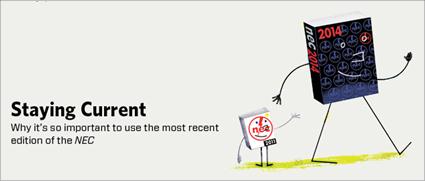Staying Current – Why it’s So Important to Use the Most Recent Edition of the NEC
An article written for NFPA Journal July August 2013 edition
By: Jeff Sargent
Published on July 1, 2013

IN AUGUST, AFTER THREE YEARS of work by the code-making panels and NFPA staff, NFPA will issue the 53rd edition of the National Electrical Code® (NEC®). The 2014 edition represents yet another milestone for the country’s most widely recognized and adopted safety code for the built environment.
While the logical next step is for the code to become the law of the land through state and local adoption, some may question the necessity of adopting the 2014 NEC when the 2011 edition is, to their thinking, “good enough.” My response is that there are numerous reasons why using the most up-to-date version of the code is always the best and safest route.
Like its predecessors, the 2014 edition of the NEC contains requirements covering a wide range of new and emerging topics. Technology development and product innovation are dynamic processes, and safety codes and standards such as the NEC are continually revised so that their requirements enable, rather than preclude, the safe integration of new products into the electrical infrastructure of homes and businesses.
A good example from the 2014 edition is the new Article 393, “Low-Voltage Suspended Ceiling Power Distribution Systems.” These systems distribute low-voltage AC or DC power that is integrated into the suspended-ceiling grid network commonly installed in office, mercantile, and institutional occupancies. These systems may be supplied by an alternative energy source, such as a photovoltaic or wind power system, to supply equipment above, below, or within the ceiling.
Another example of the way the NEC has evolved to meet emerging safety concerns is the way it addresses photovoltaic (PV) installations. Recent federal and state incentives, as well as the maturation of the industry, have resulted in thousands of new PV installations that, in turn, may have unintended consequences for those responding to emergencies at rooftop installations. That’s why the 2014 edition of the NEC includes a new requirement that addresses the rapid shutdown of PV systems installed in or on buildings, providing first responders a way to quickly lower the voltage on PV system conductors. This is one more way the NEC addresses important safety concerns without obstructing the implementation of a proliferating energy source.
Hand-in-hand with evolving code requirements is the need to train qualified installers and inspectors on these new technologies to ensure that the installations and those who service them are safe. Training programs for electricians and inspectors based on the 2014 edition of the NEC will be provided throughout the United States by a number of different organizations.
So is the previous version of the code really “good enough”? Absolutely, for the period of time when it was current. As these examples illustrate, however, the electrical world is dynamic and fast-moving, and the only way to keep pace safely is by using the most up-to-date safety requirements. Older codes can actually be a barrier to implementing new technology and methods that, in many cases, provide economic benefits for electrical consumers.
The subject matter experts brought together by NFPA have done their part to make the NEC as current as possible, and now it’s up to those responsible for adopting safety codes to do theirs. That means making sure the requirements covering new products and methods hit their intended target and protect people and property from the hazards that naturally arise from the use of electricity.
Jeffrey Sargent is a regional electrical code specialist for NFPA.
NFPA Journal July August 2013 edition



